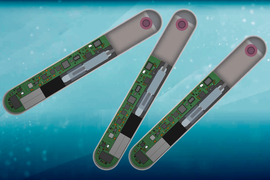In 2023, more than 100,000 Americans died from opioid overdoses. The most effective way to save someone who has overdosed is to administer a drug called naloxone, but a first responder or bystander can’t always reach the person who has overdosed in time.
Researchers at MIT and Brigham and Women’s Hospital have developed a new device that they hope will help to eliminate those delays and potentially save the lives of people who overdose. The device, about the size of a stick of gum, can be implanted under the skin, where it monitors heart rate, breathing rate, and other vital signs. When it determines that an overdose has occurred, it rapidly pumps out a dose of naloxone.
In a study appearing today in the journal Device, the researchers showed that the device can successfully reverse overdoses in animals. With further development, the researchers envision that this approach could provide a new option for helping to prevent overdose deaths in high-risk populations, such as people who have already survived an overdose.
“This could really address a significant unmet need in the population that suffers from substance abuse and opiate dependency to help mitigate overdoses, with the initial focus on the high-risk population,” says Giovanni Traverso, an associate professor of mechanical engineering at MIT, a gastroenterologist at Brigham and Women’s Hospital, and the senior author of the study.
The paper’s lead authors are Hen-Wei Huang, a former MIT visiting scientist and currently an assistant professor of electrical and electronic engineering at Nanyang Technological University in Singapore; Peter Chai, an associate professor of emergency medicine physician at Brigham and Women’s Hospital; SeungHo Lee, a research scientist at MIT’s Koch Institute for Integrative Cancer Research; Tom Kerssemakers and Ali Imani, former master’s students at Brigham and Women’s Hospital; and Jack Chen, a doctoral student in mechanical engineering at MIT.
An implantable device
Naloxone is an opioid antagonist, meaning that it can bind to opioid receptors and block the effects of other opioids, including heroin and fentanyl. The drug, which is given by injection or as a nasal spray, can restore normal breathing within just a few minutes of being administered.
However, many people are alone when they overdose, and may not receive assistance in time to save their lives. Additionally, with a new wave of synthetic, more potent opioids sweeping the U.S., opioid overdoses can be more rapid in onset and unpredictable. To try to overcome that, some researchers are developing wearable devices that could detect an overdose and administer naloxone, but none of those have yet proven successful. The MIT/BWH team set out to design an implantable device that would be less bulky, provide direct injection of naloxone into the subcutaneous tissue, and eliminate the need for the patient to remember to wear it.
The device that the researchers came up with includes sensors that can detect heart rate, breathing rate, blood pressure, and oxygen saturation. In an animal study, the researchers used the sensors to measure all of these signals and determine exactly how they change during an overdose of fentanyl. This resulted in a unique algorithm that increases the sensitivity of the device to accurately detect opioid overdose and distinguish it from other conditions where breathing is decreased, such as sleep apnea.
This study showed that fentanyl first leads to a drop in heart rate, followed quickly by a slowdown of breathing. By measuring how these signals changed, the researchers were able to calculate the point at which naloxone administration should be triggered.
“The most challenging aspect of developing an engineering solution to prevent overdose mortality is simultaneously addressing patient adherence and willingness to adopt new technology, combating stigma, minimizing false positive detections, and ensuring the rapid delivery of antidotes,” says Huang. “Our proposed solution tackles these unmet needs by developing a miniaturized robotic implant equipped with multisensing modalities, continuous monitoring capabilities, on-board decision making, and an innovative micropumping mechanism.”
The device also includes a small reservoir that can carry up to 10 milligrams of naloxone. When an overdose is detected, it triggers a pump that ejects the naloxone, which is released within about 10 seconds.
In their animal studies, the researchers found that this drug administration could reverse the effects of an overdose 96 percent of the time.
“We created a closed-loop system that can sense the onset of the opiate overdose and then release the antidote, and then you see that recovery,” Traverso says.
Preventing overdoses
The researchers envision that this technology could be used to help people who are at the highest risk of overdose, beginning with people who have had a previous overdose. They now plan to investigate how to make the device as user-friendly as possible, studying factors such as the optimal location for implantation.
“A key pillar of addressing the opioid epidemic is providing naloxone to individuals at key moments of risk. Our vision for this device is for it to integrate into the cascade of harm-reduction strategies to efficiently and safely deliver naloxone, preventing death from opioid overdose and providing the opportunity to support individuals with opioid use disorder,” says Chai.
The researchers hope to be able to test the device in humans within the next three to five years. They are now working on miniaturizing the device further and optimizing the on-board battery, which currently can provide power for about two weeks.
The research was funded by Novo Nordisk, the McGraw Family Foundation at Brigham and Women’s Hospital, and the MIT Department of Mechanical Engineering.













